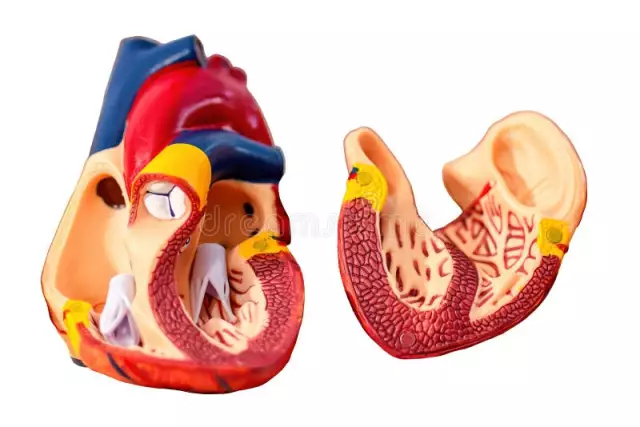- Author Curtis Blomfield [email protected].
- Public 2023-12-16 20:44.
- Last modified 2025-01-23 17:01.
The organs of hearing allow you to perceive the variety of sounds of the outside world, recognize their nature and location. Through the ability to hear, a person acquires the ability to speak. The organ of hearing is the most complex, finely tuned system of three sections connected in series.
Outer ear
The first section is an auricle - a complex cartilaginous plate, covered with skin on both sides, and an external auditory canal.

The main function of the auricle is the acceptance of acoustic vibrations of the air. From the hole in the auricle begins the external auditory meatus - a tube 27 - 35 mm long, going deep into the temporal bone of the skull. In the skin lining the ear canal, there are sulfur glands, the secret of which prevents the infection from entering the organ of hearing. The tympanic membrane, a thin but strong membrane, separates the outer ear from the second part of the hearing organ, the middle ear.
Middle ear
In the deepening of the temporal bone is the tympanic cavity, which forms the main part of the middle ear. Auditory (Eustachian)The tube is the link between the middle ear and the nasopharynx. When swallowing, the Eustachian tube opens and allows air to enter the middle ear, which balances the pressure in the tympanic cavity and the external auditory canal.

In the middle ear are miniature auditory ossicles movably connected to each other - a complex mechanism for transmitting acoustic vibrations coming from the external auditory canal to the auditory cells of the inner ear. The first bone is the malleus, with a long end attached to the eardrum. The second is an anvil connected to a third miniature bone, the stirrup. The stirrup is adjacent to the oval window from which the inner ear begins. The bones that include the organ of hearing are very small. For example, the mass of a stirrup is only 2.5 mg.
Inner ear
The third part of the organ of hearing is represented by the vestibule (miniature bone chamber), semicircular canals and a special formation - a thin-walled bone tube twisted into a spiral.

This part of the auditory analyzer, shaped like a grape snail, is called the cochlea.
The hearing organ has important anatomical structures that allow you to maintain balance and assess the position of the body in space. These are the vestibule and semicircular canals, filled with fluid and lined from the inside with very sensitive cells. When a person changes the position of the body, there is a displacement of fluid in the channels. Receptors fixfluid displacement and send a signal about this event to the brain. This is how the organ of hearing and balance allows the brain to learn about the movements of our body.
The membrane located inside the cochlea consists of about 25 thousand of the thinnest fibers of various lengths, each of which responds to sounds of a certain frequency and excites the endings of the auditory nerve. Nervous excitation is first transmitted to the medulla oblongata, then reaches the cerebral cortex. In the auditory centers of the brain, irritations are analyzed and systematized, as a result of which we hear sounds that fill the world.






